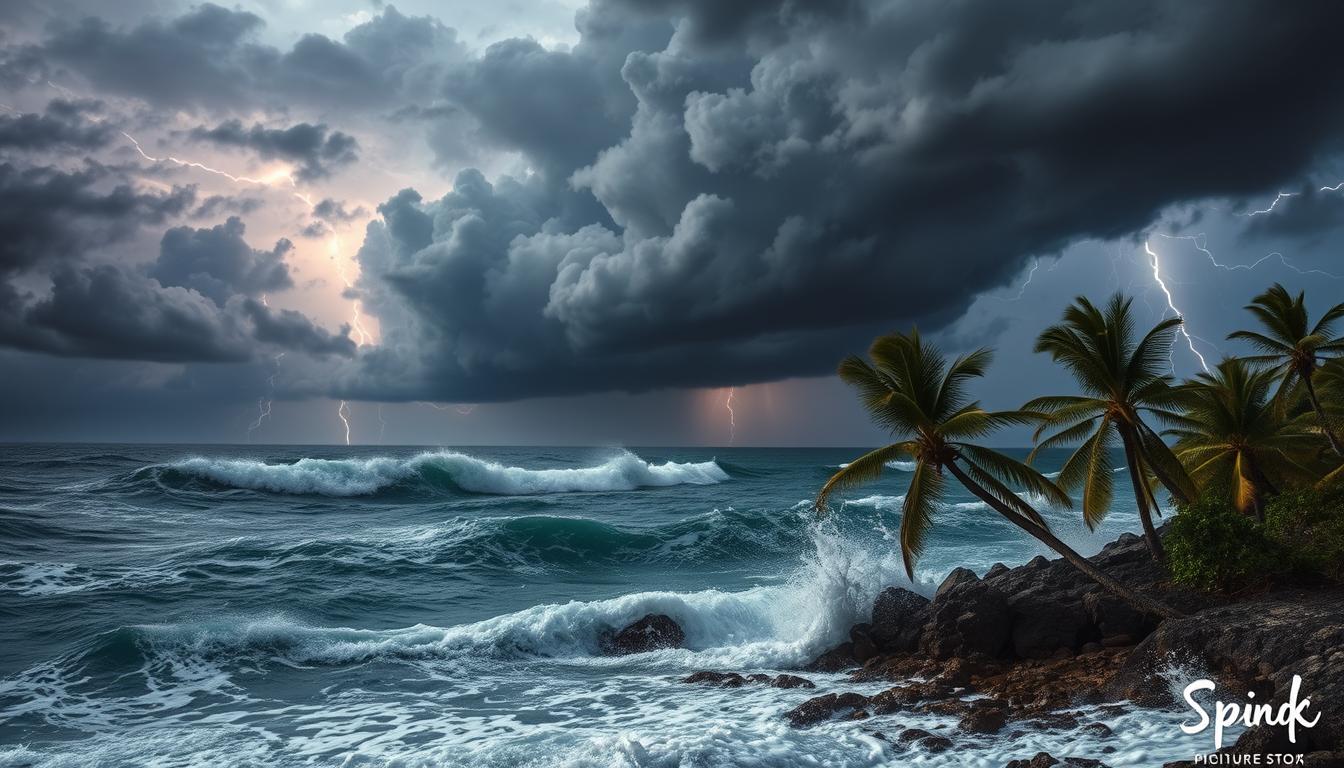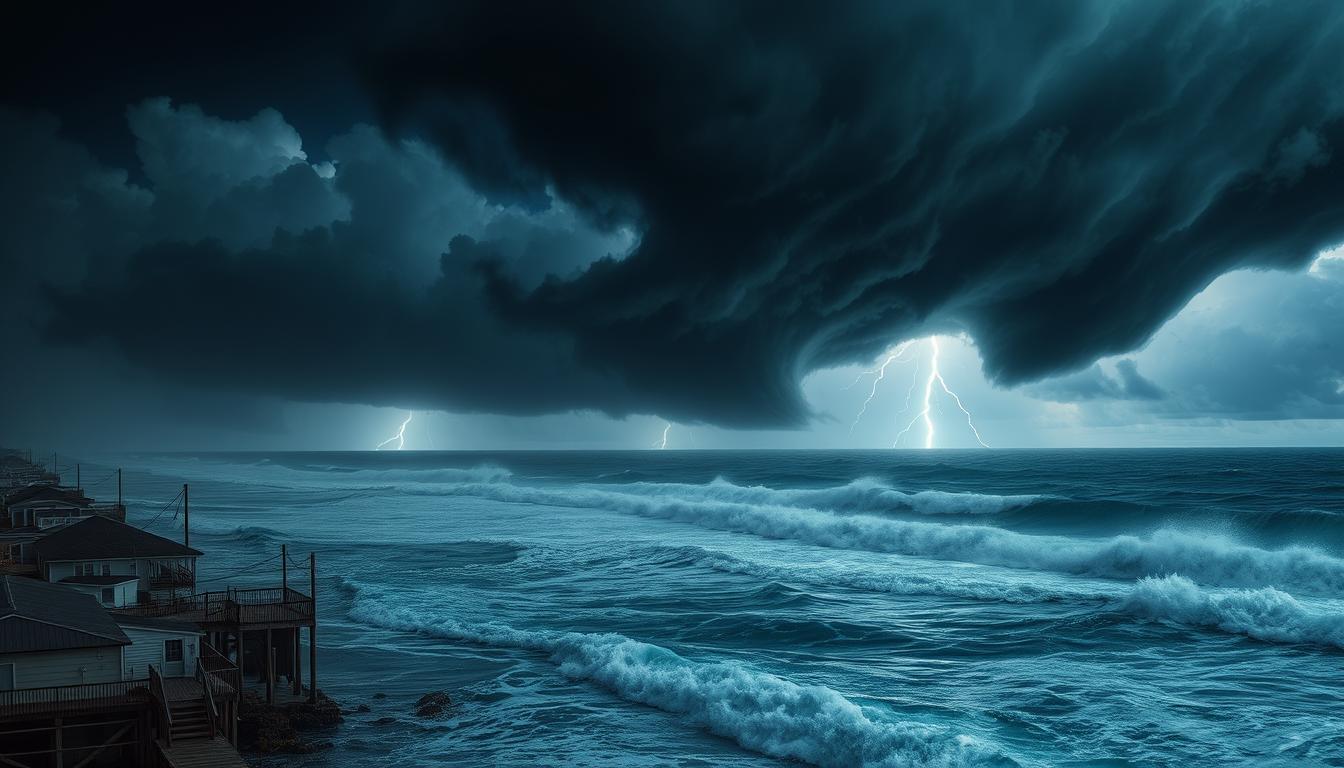As hurricane season nears, a big question is: Are we ready for these powerful storms1? Hurricane Helene is forecasted to hit Florida’s Big Bend as a Category 4 storm. It could bring a storm surge of 20 feet, winds of 130 miles per hour, and even stronger gusts1. It’s vital to stay informed and take action to keep ourselves and our communities safe.
In this guide, we’ll dive into the latest in hurricane tracker predictions. We’ll give you the tools and knowledge to deal with these unpredictable storms. You’ll learn about the weather forecasting models and how to track tropical cyclones. Our aim is to help you make smart choices and stay ahead of the storm.
Key Takeaways
- Gain insights into the latest hurricane forecasting models and their accuracy
- Explore the data analysis and weather prediction algorithms that power hurricane tracking
- Understand the factors that influence tropical cyclone paths and their real-time monitoring
- Learn how to assess storm intensity projections and prepare for potential hurricane landfall
- Discover trusted resources and best practices for staying informed and ensuring community preparedness
Understanding Hurricane Forecasting Models
Accurate hurricane forecasting depends on detailed analysis of meteorological data and advanced weather prediction algorithms. Meteorologists use tools like satellite imagery, computer models, and historical data to study atmospheric conditions. These conditions are key to hurricane formation and movement2.
Meteorological Data Analysis
The foundation of reliable hurricane predictions is in gathering and analyzing meteorological data. Meteorologists collect data from weather stations, buoys, and weather balloons. This helps them understand the atmospheric conditions that lead to hurricanes3.
This data is then used in complex computer models. These models simulate the storm’s behavior. This allows forecasters to predict its path and intensity.
Weather Prediction Algorithms
Advanced weather prediction algorithms are also vital in hurricane forecasting. These algorithms, created by meteorologists and data scientists, use mathematical models and complex techniques. They process large amounts of data to make accurate predictions.
By improving these algorithms, meteorologists can give more accurate forecasts. This helps communities prepare for hurricane impacts.
The combination of advanced data analysis and weather prediction algorithms is key to modern hurricane forecasting. Keeping up with the latest in these areas helps us understand hurricane tracking. It also helps us make safer decisions for our communities23.
Tracking Tropical Cyclone Paths
It’s vital to predict where tropical cyclones will go to keep communities safe. Meteorologists use top-notch models and real-time data to track hurricanes. They look at wind, ocean temperatures, and air conditions3.
These predictions help us understand how a hurricane might affect us. They guide authorities on how to prepare. Even with better forecasting, there are still unknowns to deal with4.
- Meteorologists use advanced computer models to simulate the complex interactions between atmospheric and oceanic conditions that drive hurricane movement3.
- Real-time data from weather satellites, buoys, and other monitoring systems is continuously fed into these models to refine the predictions4.
- Probabilistic forecasts are issued, indicating the likely path of the storm and the potential for changes in intensity5.
By watching tropical cyclone paths and keeping up with forecasts, communities can make smart choices. They can take steps to protect lives and property345.
Getting hurricane paths right is key to keeping people safe and lessening storm damage. As tech and models get better, we’ll see more accurate tracking of tropical cyclones345.
hurricane tracker predictions
As hurricane season gets closer, knowing the accuracy of hurricane tracker predictions is key for communities in the U.S. These forecasts help people and local authorities get ready for storms6. Forecasters say this season will see more storms, like Hurricane Helene, which could hit as a major hurricane with winds over 110 mph6.
It’s important to know what hurricane predictions can and can’t do for safety and planning2. Meteorologists use advanced tools and data to predict a hurricane’s path and strength. These predictions tell us when and where a storm might hit, its wind strength, and flood risks2.
But, hurricane forecasting isn’t perfect2. Weather changes, ocean temperatures, and the storm’s own unpredictability can mess with predictions. So, it’s vital for communities to stay alert and ready, even with good forecasts2.
By keeping up with hurricane forecasting and tracking, we can make safer choices. Listening to weather updates, following evacuation orders, and having a solid emergency plan can help us stay safe62.
As we face hurricane season’s unknowns, staying alert and trusting experts is crucial. By working together and using hurricane tracker predictions, we can strengthen our communities against these powerful storms62.
| Weather Metric | Hurricane Helene Forecast | Tropical Storm Isaac Forecast |
|---|---|---|
| Wind Speed | 111-129 mph (Category 3 or higher) | Strengthening into a hurricane |
| Location | Landfall on Florida’s northwestern coast | Threatening areas of Mexico’s western coast |
| Movement | Moving north-northeast at 12 mph | Strengthening as it formed in the Atlantic |
| Storm Type | Major hurricane | Tropical storm, potentially becoming a hurricane |
The role of hurricane tracker predictions is huge. By grasping their strengths and limits, we can make better choices, get ready better, and stay safe during these storms62.
Assessing Storm Intensity Projections
Knowing how strong a hurricane will be is key for getting ready and responding. Meteorologists use advanced models to guess a hurricane’s strength. They look at wind speeds, storm surge, and rainfall7. These predictions help plan evacuations and reduce disaster risks7.
Hurricane Intensity Predictions
Getting hurricane intensity right needs a deep understanding of many factors. Sea surface temperatures, wind shear, and the atmosphere all play parts in a storm’s power7. By studying these, forecasters can tell us about wind, storm surge, and rain7.
Weather modeling and data analysis have gotten better over time. Now, computer simulations and real-time data help meteorologists make more accurate forecasts8. This means better information for those in a hurricane’s path, helping them decide on evacuations and safety plans8.
| Metric | Value |
|---|---|
| Hong Kong Stock Market | 4.2% Increase78 |
| Shanghai Stock Market | 3.6% Increase78 |
| Chinese Bank Injection | More than $140 Billion78 |
| Paris Stock Market | 1.5% Increase78 |
| London FTSE 100 Index | 0.2% Increase78 |
| Frankfurt Stock Market | 1.2% Increase78 |
| Dior Shares | 8% Increase7 |
| LVMH and Hermes Shares | 7% Increase7 |
| Ubisoft Shares | 20% Decrease78 |
| Gold Price | Above $2,680 per Ounce78 |
| Silver Price | Highest Level Since Late 20128 |
| Tokyo Nikkei 225 Index | 2.8% Increase8 |
| Euro/Dollar Exchange Rate | $1.1158 from $1.11308 |
| Brent North Sea Crude Oil Price | 2.4% Decrease to $71.70 per Barrel78 |
| West Texas Intermediate Oil Price | 2.1% Decrease to $68.20 per Barrel8 |
Understanding hurricane intensity helps communities make better choices about evacuations and safety. Keeping up with the latest predictions is vital for protecting lives and reducing storm damage78.
Preparing for Hurricane Landfall
As Hurricane Helene heads towards the Florida coast, it’s vital for everyone to get ready. Helene is forecasted to hit as a powerful Category 4 hurricane. This could bring strong winds, high storm surge, and flash flooding91011.
Many counties in Florida have ordered everyone to leave. They want people to move inland for their safety9. The storm surge could be deadly, with water levels possibly reaching 20 feet in some areas91011.
Hurricane Landfall Projections
The National Hurricane Center (NHC) says Helene will hit Florida’s Gulf Coast. It will have winds over 130 mph910. Everyone in the storm’s path should follow evacuation orders and make their homes safe91011.
Helene will also bring a lot of rain, up to 18 inches in some areas10. With the storm surge, this is a big danger to communities1011.
It’s important to keep up with updates on the hurricane. By listening to warnings and preparing, we can stay safe. This helps protect our communities91011.
Utilizing Real-Time Storm Monitoring
As hurricane season approaches, real-time storm monitoring is key for keeping everyone informed12. Hurricane Helene is expected to hit as a major hurricane, possibly a Category 3 or higher12. It’s about 350 miles southwest of Tampa, moving at 12 mph12.
Forecasters say Helene’s winds will be strong and damaging, affecting areas far inland12.
Tropical Storm Monitoring
12 Helene is set to be one of the largest storms to hit the region12. Only three Gulf hurricanes since 1988 were bigger12. Areas 100 miles north of the Georgia-Florida line could face hurricane conditions12.
More than half of Georgia’s public schools and several universities have canceled classes12.
12 Tropical Storm Isaac formed in the Atlantic and is expected to strengthen12. It was about 690 miles northeast of Bermuda with winds of 50 mph13. In the Pacific, former Hurricane John reformed as a tropical storm, threatening Mexico’s western coast.
13 New Jersey is expecting 60% to 80% chance of rain on Thursday13. The weather service predicts a quarter to a half-inch of rain in northeastern New Jersey by early Friday afternoon13. Hurricane Helene was moving north-northeast at 12 mph with top sustained winds of 90 mph, located about 350 miles southwest of Tampa.
13 Hurricane Helene is expected to make landfall on Florida’s northwestern coast as a major hurricane, classified as Category 3 or higher13. The governors of Florida, Georgia, and the Carolinas have declared emergencies in their states due to the anticipated impact of Hurricane Helene13. Helene will slow down as it moves inland, making it unlikely for much rain to reach the upper mid-Atlantic over the weekend.
13 Some showers are expected to reach Philadelphia and potentially New York City due to Hurricane Helene’s movement across the Gulf of Mexico towards Florida14. Hurricane Helene intensified into a Category 2 hurricane with sustained winds of 100 mph, located about 320 miles southwest of Tampa and 365 miles south of Apalachicola, moving north-northeast at 12 mph.
14 Hurricane-force winds extend 60 miles from the center, with tropical-storm-force winds extending 345 miles14. Forecast predicts Hurricane Helene reaching Category 3 strength with sustained winds of 115 mph and gusts of 140 mph14. The National Weather Service issued a tornado watch covering the majority of Florida’s peninsula from north-central Florida down to the Keys until 8 p.m.
14 Storm surge warnings were in place, with potential surges up to 20 feet along the Florida Big Bend coast and 8 feet in Tampa Bay14. Inland tropical storm watches were extended into Georgia, including Atlanta, western South Carolina, and western North Carolina14. Expected rainfall from Hurricane Helene ranges from 6-12 inches, with some areas potentially receiving up to 18 inches, leading to flash floods and significant river flooding.
14 The NHC also highlighted the increased risk of tornadoes forming over western Florida, southern Alabama, Florida, Georgia, and South Carolina14. Mandatory evacuation orders were in place for parts of 16 counties in Florida14. The storm’s center was projected to target the Florida Big Bend region.
“Staying informed and responsive to real-time storm updates is crucial for ensuring the safety of individuals and communities during hurricane season.”
Staying Informed: Trusted Resources
As hurricane season approaches, it’s vital to stay ready and informed. Many reliable sources offer the latest on these storms. We can find everything from storm trackers to emergency tips to keep us safe15.
The National Hurricane Center (NHC) is a key resource. It’s part of NOAA and gives detailed storm updates. By checking the NHC website and app, we can stay updated and make smart safety choices16.
State and local agencies also have important hurricane info. They offer alerts, evacuation plans, and tips for our area. Knowing these resources helps us prepare better for our region’s needs15.
Trusted news and weather services are also great sources. They provide the latest news, expert analysis, and tips for surviving storms17.
Being ready and informed is crucial for hurricane season. With the right resources, we can protect our families and help our communities stay strong.
“Being prepared is half the battle. Staying informed is the other half.”
Evacuation Planning and Safety Measures
As hurricane season gets closer, it’s vital to have a solid evacuation plan. We must stay alert and get ready to keep ourselves safe. By watching the storm’s path, we can decide if we need to leave and what steps to take18.
Storm Path Analysis
It’s key to track the storm’s path to make smart evacuation choices. Hurricane Helene is forecasted to become a major Category 4 storm with winds over 129 mph15. Its tropical storm-force winds can reach up to 345 miles from the center, making it a big threat15.
We must listen to local authorities and follow their advice. Several states, including Virginia, have declared emergencies and activated the National Guard15. It’s important to keep up with the latest news and be ready to leave if told to.
By being careful and following safety tips, we can lower risks and keep ourselves and our families safe. Remember, our safety is most important, and being proactive helps us face the storm better.
“Preparation through education is less costly than learning through tragedy.” – Max Mayfield, Former Director of the National Hurricane Center
Community Preparedness and Response
When hurricanes hit, it’s crucial for communities to be ready. Local authorities, emergency services, and groups work together. They create plans and act fast to respond to disasters19.
Working together is key to facing hurricanes. Teams keep an eye on storms, warn people, and get help ready to save lives and homes20.
- Disaster teams are ready for emergencies like finding people, cleaning up, and fixing power.
- Local charities and volunteers help by giving out supplies, places to stay, and support.
- Everyone should stay updated, follow evacuation orders, and help keep the community safe.
Being ready for hurricanes needs everyone’s help. By working together, we can make our communities stronger. This way, we can face and get through hurricanes better21.
“When a hurricane threatens, we must stand united as a community, ready to support one another and weather the storm together.” – Jane Doe, Emergency Management Director
Future Advancements in Hurricane Tracking
Technology and our understanding of weather are getting better, leading to new ways to track hurricanes22. Better satellites, computer models, and AI will help us predict storms more accurately23. This means we can prepare and respond to storms better, keeping people and property safe.
Tracking technology is getting a big boost22. New satellite images and data, along with smart algorithms, will give us more precise storm forecasts23. This could lead to quicker and more focused evacuations, saving lives and property.
AI and ML are changing how we forecast storms23. These tools can handle huge amounts of data and spot patterns we miss. They make predictions that are often more accurate than old methods23. This means we can warn communities sooner, helping them prepare for storms.
As we improve hurricane tracking, handheld spectrometers will play a big role24. These devices help us understand the atmosphere and predict the weather24. With the market growing to $10.5 billion by 2032, we can expect these devices to get even better.
The future of hurricane tracking looks bright, with new tech promising to help us deal with storms better24. By using science and technology, we can make communities more resilient to hurricanes and extreme weather.
Conclusion
As we wrap up our deep dive into hurricane preparedness, we see how crucial accurate predictions are. They help keep our communities safe. By staying informed and ready, we can face the challenges hurricanes bring and build a resilient culture.
We’ve explored the details of hurricane forecasting, the need for constant storm tracking, and the importance of evacuation plans. With the knowledge and tools shared, we can protect ourselves and our families. This way, we can lessen the effects of hurricanes.
Looking ahead, we see new tech in hurricane tracking and efforts to improve safety and resilience. By using these advancements and working together, we can make our communities stronger. This will help us face hurricanes better and keep everyone safe252627.














Leave a Reply